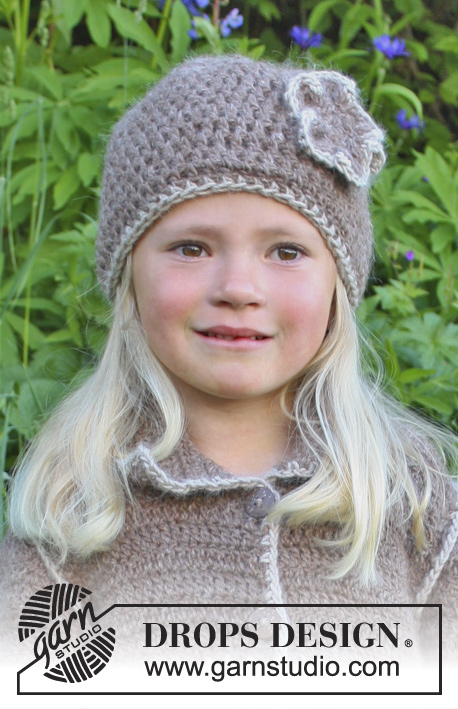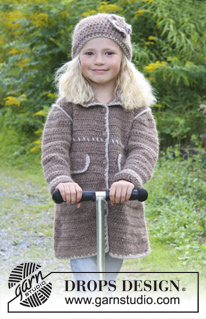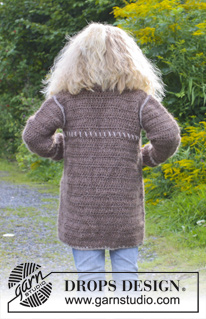Matilda |
|
 |
 |
Crochet DROPS coat and hat with decorative edges in ”DROPS ♥ YOU #4” or ”Nepal”. Size 3 - 12 years.
DROPS Extra 0-938 |
|
|
CROCHET INFO COAT: Replace first tr on row with 3 ch. DECREASE TIP COAT: Dec 1 tr by working 2 tr tog as follows: Work 1 tr in first tr but wait with last pull through, work 1 tr in next tr but on last pull through, pull yarn through all 3 loops on hook. Dec 2 tr by working 3 tr tog as follows: Work 1 tr in first tr but wait with last pull through, work 1 tr in next tr but wait with last pull through, work 1 tr in next tr but on last pull through, pull yarn through all 4 loops on hook. CROCHET INFO HAT: Beg every tr round with 3 ch instead of first tr. Finish every round with 1 sl st in 3rd ch from beg of round. Beg every dc round with 1 ch instead of first dc. Finish every round with 1 sl st in 1st ch from beg of round. INCREASE TIP HAT: Inc 1 tr by working 2 tr in same tr. -------------------------------------------------------- BACK PIECE: Work 61-63-68-73-78 ch with light brown on hook size 6 mm. Turn and work 1 tr in 4th ch from hook, continue with 1 tr in each of the next 2-4-4-4-4 ch, * skip 1 ch, 1 tr in each of the next 4 ch *, repeat from *-* the entire row = 48-50-54-58-62 tr - READ CROCHET INFO! Continue with tr upwards on all rows. REMEMBER THE CROCHET TENSION! When piece measures 15 cm, dec 1 tr in each side by working the second and third tr and the 2 next to last tr tog – SEE DECREASE TIP! Repeat dec every 5-5-6-6-7 cm 3 more times = 40-42-46-50-54 tr. When piece measures 33-36-39-42-45 cm, dec for armholes in each side as follows: Work sl sts over the first 2-2-3-4-5 tr, then work tr until 2-2-3-4-5 tr remain, turn piece. Continue with tr, there are now 36-38-40-42-44 tr on row. Continue to work until piece measures approx. 47-51-55-59-63 cm. Now work 1 row with tr only over the outermost 12-13-13-14-14 tr in each side for shoulder (the middle 12-12-14-14-16 tr = neck). Fasten off. RIGHT FRONT PIECE: Work 34-36-38-41-43 ch with light brown on hook size 6 mm. Turn and work 1 tr in 4th ch from hook, continue with 1 tr in each of the next 5-2-4-2-4 ch, * skip 1 ch, 1 tr in each of the next 4 ch *, repeat from *-* the entire row = 27-28-30-32-34 tr. Continue with tr upwards on all rows (the 3 outermost tr towards mid front = band). When piece measures 15 cm, beg dec in the side as on back piece. When dec are done, 23-24-26-28-30 tr remain on row. When piece measures 33-36-39-42-45 cm, the outermost 2-2-3-4-5 tr towards the side are no longer worked. Continue with tr over the remaining 21-22-23-24-25 tr. When piece measures 43-47-50-54-57 cm, the outermost 7-7-8-8-9 tr towards mid front are no longer worked. Then dec 1 tr towards mid front on the next 2 rows by working the 2 next to last tr towards mid front tog = 12-13-13-14-14 tr remain on shoulder. Fasten off when piece measures 48-52-56-60-64 cm. LEFT FRONT PIECE: Work as right but reversed. SLEEVE: Work 32-32-32-39-39 ch with light brown on hook size 6 mm. Turn and work 1 dc in 2nd ch from hook, then work 1 dc in each of the next 5-5-5-2-2 ch, * skip 1 ch, work 1 dc in each of the next 4 ch *, repeat from *-* the entire row = 26-26-26-31-31 dc (first ch on row does NOT count as 1 dc). Turn piece and continue with 1 tr in every dc. When piece measures 10 cm, inc 1 tr in each side by working 2 tr in second and next to last tr. Repeat inc every 2-2-2-3-3 rows 3-4-5-4-5 more times = 34-36-38-41-43 tr. When piece measures 26-30-34-37-41 cm, beg dec for sleeve cap. Work sl sts over the first 3 tr, then work tr until 3 tr remain, turn piece. Work 3 ch, then work the next 3 tr tog – SEE DECREASE TIP! Work tr until 4 tr remain, work the next 3 tr tog, then 1 tr in last tr. Continue like this by working the 3 next to last tr on every row tog until piece measures 33-37-41-45-49 cm, fasten off. ASSEMBLY: Sew shoulder seams, side seams and sleeve seams edge to edge to avoid a chunky seam. Sew in the sleeves in body. Fasten the buttons on left front piece, the top button approx. 2 cm from neck/beg of collar, the bottom button approx. 12 cm from bottom edge. Place the rest of the buttons evenly between these 2 buttons. Button through band on right front piece. COLLAR: Work 35-50 dc around the neck with light brown on hook size 6 mm. Continue with 1 dc in every dc until collar measures approx. 6-7-7-8-8 cm. Fasten off. DIAGONAL STITCHES: Sew diagonal stitches with beige under chest and on the back. Approx. 1-2 cm below armhole. Stitches should go over approx. 1.5 x 1.5 cm. DECORATIVE POCKETS: Work 18-18-20-20-22-22 ch (incl 1 ch to turn with) on hook size 6 mm with light brown. Work 1st row as follows: 1 dc in 2nd ch, 1 dc in each of the next 2 ch, skip 1 ch, * 1 dc in each of the next 3 ch, skip 1 ch *, repeat from *-* and finish by working 1 dc in each of the last 1-1-3-3-1-1 ch = 13-13-15-15-16-16 dc. Then work 1 dc in every dc until approx. 6-6-6-7-7-7 cm have been worked. Fasten off. Work another decorative pocket. Sew the decorative pockets approx 3-5 cm below the diagonal stitches on each front piece. Sew with neat stitches along upper edge of pocket and sew 1 stitch in each bottom corner. CROCHET EDGES: Work around all edges on jacket with beige on hook size 6 mm. Start mid back on collar. Work 1 dc, * 1 ch, skip approx. 1 cm, 1 dc in next st *, repeat from *-* around the collar, down along front piece, around the edge at the bottom and up along front piece and back of neck again. Finish with 1 sl st in dc from beg of round. Work the same way at around the bottom of the sleeves and around the loose edge on pockets. CROCHET EDGE (around armholes): Work an edge around the sleeve, on the over side of where sleeve has been fastened in front and back piece. Use crochet hook size 6 mm and beg under sleeve. Work 1 dc, * 1 ch, skip approx. 1 cm, 1 dc *, repeat from *-* around the entire armhole and finish with 1 sl st in first dc at beg of round. -------------------------------------------- HAT: The piece is worked top down. Work 4 ch on hook size 6 mm with light brown and form a ring with 1 sl st in first ch. REMEMBER THE CROCHET TENSION! ROUND 1: Read CROCHET INFO! Work 8 tr in ch-ring. ROUND 2: 2 tr in every tr the entire round = 16 tr. ROUND 3: * 1 tr in first tr, 2 tr in next tr *, repeat from *-* the entire round = 24 tr. ROUND 4: * 1 tr in each of the first 2 tr, 2 tr in next tr *, repeat from *-* the entire round = 32 tr. ROUND 5: * 1 tr in each of the first 3 tr, 2 tr in next tr *, repeat from *-* the entire round = 40 tr. ROUND 6: * 1 tr in each of the first 4 tr, 2 tr in next tr *, repeat from *-* the entire round = 48 tr. ROUND 7: * 1 tr in each of the first 5 tr, 2 tr in next tr *, repeat from *-* the entire round = 56 tr. Finish inc in size 3/5 years here. ROUND 8: ONLY WORKED IN SIZE 6/9 – 10/12: Work 1 tr in every tr AT THE SAME TIME inc 3-6 tr evenly READ INCREASE TIP! = 59-62 tr ALL SIZES: Now work 1 tr in every tr on every round until piece measures approx. 18-19-20 cm. Switch to beige and work 1 dc in every tr the entire round. Fasten off. CROCHET FLOWER: Work 6 ch with light brown on hook size 6 mm and form a ring with 1 sl st in first ch. ROUND 1: Work 1 ch, 1 htr in ch-ring, * 7 ch, 1 sl st through the 2 strands at the front of previous htr, 2 htr in ch-ring *, repeat from *-* until 5 ch-spaces have been worked, 7 ch, 1 sl st through the 2 strands at the front of previous htr, 1 htr in ch-ring and finish with 1 sl st in 1st ch from beg of round. ROUND 2: Work sl sts until first ch-space. Work 1 ch, work 12 htr in space, * work 12 htr in next ch-space *, repeat from *-* in all ch-spaces and finish with 1 sl st in 1st ch from beg of round. Cut the yarn and pull it through. ROUND 3: Switch to beige and beg with 1 sl st in second htr on 1st round, 1 ch, 1 dc in same st. Fold ch-spaces towards you and work 1 dc in 1 of the strands at the back of all htr (the top of htr from previous row tilts forwards and is clearly visible from front). Between all spaces work 1 very loose dc in second htr from 1st round. Finish with 1 sl st in first ch from beg of round. Cut the yarn and pull it through. ASSEMBLY: Sew the flower on to the hat. Fasten off. |
|

|
|
|
Have you made this or any other of our designs? Tag your pictures in social media with #dropsdesign so we can see them! Do you need help with this pattern?You'll find tutorial videos, a Comments/Questions area and more by visiting the pattern on garnstudio.com. © 1982-2024 DROPS Design A/S. We reserve all rights. This document, including all its sub-sections, has copyrights. Read more about what you can do with our patterns at the bottom of each pattern on our site. |
|





































Comments / Questions (8)
Hej jag kan inte hitta knapparna hos er? I kokos? Vilken storlek är det på dem? Och vilka är likvärdiga som dem? Mvh
15.02.2020 - 22:09DROPS Design answered:
Hej Det är knapp 515 som är 20 mm i diameter och du hittar den under knappar på vår hemsida. Lycka till!
17.02.2020 - 09:27,Hejsan! Har gjort denna söta kappa till mitt barn-barn, stor succé. Nu skulle jag ville göra en likadan till mig själv? Hur ska man göra för att få till en stl 38-40?? Vänliga hälsningar Ingrid
14.04.2018 - 18:01DROPS Design answered:
Tyvärr har vi inte just nu resurser att räkna om mönstret till vuxen stl. Se gärna på våra andra virkmönster i vuxen storlek.
17.04.2018 - 13:39Bonjour comment assemblez vous les côtés de la veste et des manches au crochet ou à l' aiguille à coudre? merci de votre aide
18.09.2016 - 17:40DROPS Design answered:
Bonjour Mme Le Corre, les 2 peuvent être envisagés, au choix, en tous les cas à ce que la couture ne soit pas trop épaisse, quelle que soit la technique que vous choisissez. Bon crochet!
19.09.2016 - 09:49Ja det läste jag med i mönstret. Så det är inte meningen att man ska göra knapphål då?
04.11.2015 - 20:31DROPS Design answered:
Nej det är inte meningen, de knäpps bara genom framkanten.
05.11.2015 - 12:20Hej. Ska det inte vara knapphål på kappan? Det står ingenstans att man ska göra knapphål men det står hur man ska sy i knapparna??! Ska knapparna knäppas genom maskorna i kappan bara??
31.10.2015 - 21:33DROPS Design answered:
Hej Anna, ja precis "Knapparna knäpps genom framkanten på höger framst" Lycka till!
02.11.2015 - 10:07Ik heb dit vest voor mijn kleindochter gemaakt geweldig het staat haar zo mooi. Nu wil ik van dezelfde wol en voor een jongetje van bijna 2 jaar een truitje maken met een capuchon en voorsluitng met grote knopen. Hebben jullie daar een patroontje van?
21.11.2014 - 19:07DROPS Design answered:
Hallo. Wij hebben maar een paar gehaakte truien/vesten, klik hier voor het zoekresultaat. Of u kunt proberen dit patroon aan te passen voor een jongetje.
27.11.2014 - 16:08Hur ska man göra "knapphålen" på Matilda barnkappa?
09.11.2014 - 10:26DROPS Design answered:
Hej Ireen. Knapparna knäpps genom framkanten på höger framst
10.11.2014 - 11:20Ik heb deze als beginner gehaakt voor 3/5 jaar. Helaas vond ik hem met toer 7 erbij echt nog te groot. Daarna nog een x gehaakt, maar dan tot toer 6 en toen gestopt met meerderen. Heb er tot 2 x toe een roze toer doorheengehaakt. Resultaat is echt super!! De maat is perfect voor een 3-5 jarige en voor een beginner ook heel goed te haken dit!! Dit wordt echt mn favo muts patroon ben ik bang!! Dank je wel Garnstudio!
29.12.2013 - 18:57